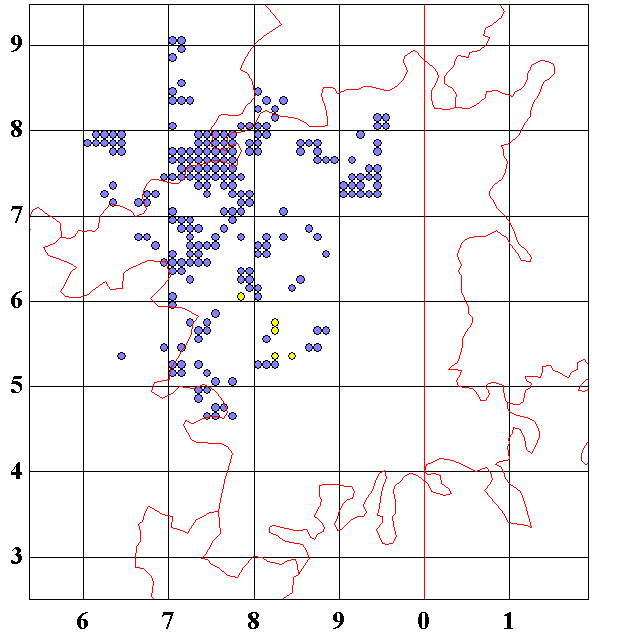
The main boundary is of VC 37 Worcestershire. Map prepared by Bert Reid.
IN SEARCH OF THE LAND CADDIS (PART 2).
Harry Green & Brett Westwood.
Avid readers of Worcestershire Record will have seen a series of reports on our searches for the elusive Land Caddis Enoicyla pusilla. These reports can also be seen on the web site www.wbrc.co.uk. Having accumulated a good deal of information on distribution we were fortunate to be commissioned to write and article on Land Caddis for British Wildlife, published in October 2005. As well as presenting an overview of knowledge on Land Caddis and a picture of its known English distribution, we hoped to stimulate interest and to encourage others to search for it elsewhere in England. Currently, this insect appears to be restricted to western Worcestershire, spreading a little into neighbouring Herefordshire, Shropshire and Staffordshire. Distribution maps are published in the British Wildlife article. Although several people have since contacted us, so far we have no definite evidence that Land Caddis occurs elsewhere in Britain.
 |
| Distribution of Land Caddis Enoicyla pusilla in Britain. The main boundary is of VC 37 Worcestershire. Map prepared by Bert Reid. |
Although we have seen hundreds of Land Caddis cases of all sizes over the last ten years, without and without living larvae, we had never seen the adult insects. After reading the reports on Land Caddis from the 1800s, examining museum specimens from those years, and reading some continental literature, it became clear that adult Land Caddis emerged in October and possibly November and were only around for a short time. Following a series of fortunate encounters with national caddis experts we therefore planned a foray to search for live adults and fixed on 14th and 15th October as dates when they might be around.
So, on the 14th October we were joined by Ian Wallace (national caddis expert from Liverpool Museum), David Pryce (local expert on ‘river flies’), Mervyn Needham ( Worcestershire Wildlife Trust reserve manager for Chaddesley Woods), Rosemary Winnal (from Wyre Forest) and David Harding (who has studied Land Caddis for many years), at the gate to Chaddesley Wood, near Bromsgrove. We particularly needed to gather together this group of experts to be sure than any adult caddis found were indeed Land Caddis. Within 10 minutes of entering Chaddesley Wood we disturbed small flying male caddis from the leaf litter and they were quickly identified as Land Caddis! Following this initial success we crossed the road to the northern section of the wood. As evening approached we found more flying males and started the serious business of searching for the tiny flightless females. Ian Wallace eventually struck female gold! Only one was found. The males seemed to be slightly more active around dusk but activity declined as it became dark and they did not appear to be attracted to light traps (as used for catching moths).
On the morning of the 15th we visited dingle woods near Lower Sapey where we had previously found Land Caddis larvae. This area is in a wet valley with tufa (travertine) deposits. Although we found other species of caddis and a few Land Caddis larval cases no adult Land Caddis were seen. In the afternoon we visited several areas in Wyre Forest. Larvae have been found throughout the forest for many years. We disturbed only a few flying males so thought it best to return to Chaddesley Wood as we very much wanted to find more female Land Caddis. We eventually found two or three but they were very difficult to locate. Gently riddling the leaf litter caused the males to fly for a short distance and the females were found amongst the riddled litter in a white tray. They are not much bigger than a large springtail!
Females are thought to attract males by emitting pheromones. We saw only fleeting possible evidence of this when a couple of males flew closely to a female as we tried to obtain pictures of her. Interestingly, David Harding returned to this site on 4th November 2005and found many tiny larvae so at least some of the adults we saw bred successfully.
Why are we so excited about these finds? Well, very few people have ever seen adult Land Caddis in the wild in England. David Harding (pers com) found occasional males in 1977, 1978, and 1981 during his studies of the larvae. Graham Vick and Bob Kemp found flying adults in 1988 and succeeded in rearing small numbers of both males and females in captivity. However, the only report we have seen of females seen in the wild is by Fletcher who, in 1868, saw a female egg-laying on moss. Fletcher of course, was the person who discovered the species in England. Our pictures of the males and females are probably the first ever taken in England.
What do we do next? Look for more Land caddis in new places! We do not think the picture of national distribution is yet complete and we plan to continue visiting likely places both within the known distribution and beyond. We also wish to encourage you to look – we shall be very pleased to hear of records (with evidence!). There is also the vexed question of why Land Caddis are only here. Maybe somebody will find them elsewhere in England. We should also like to obtain more data on the length and timing of the emergence period and plan daily searches during the likely period. There is also little data on where and when pupation occurs. We should like to see the pupae!
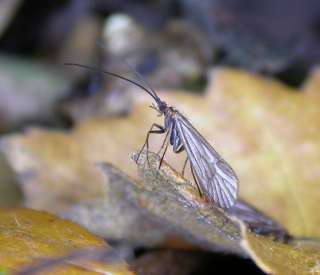 |
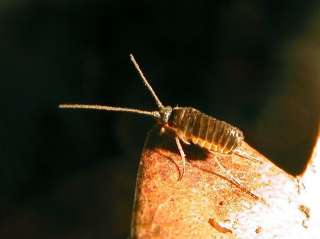 |
|
Male Land Caddis Enoicyla pusilla. Body length about 5 mms Picture © G H Green |
Female Land Caddis Enoicyla pusilla. Note the tiny vestigial wing stump. Total length head to rear end about 4 mm. Picture © Rosemary Winnall. |
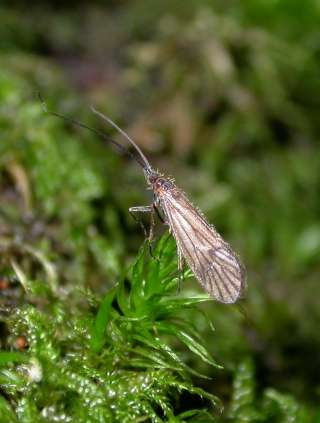 |
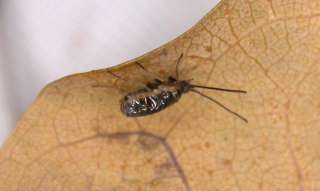 |
|
Male Land Caddis Enoicyla pusilla. Picture © G H Green |
Female Land Caddis Enoicyla pusilla. Picture © G H Green |
With grateful thanks to all fellow caddis friends and searchers and to all those who have sent us records.
References
| GREEN G H & WESTWOOD 2005. In search of the Land Caddis Enoicyla
pusilla. British Wildlife 17.no 1, pages 21-26 |
| WBRC Home | Worcs Record Listing by Issue | Worcs Record Listing by Subject |